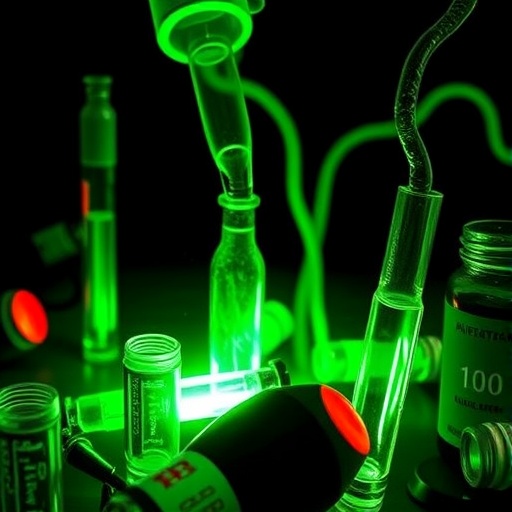In an era where pollution control is of paramount importance, researchers are relentlessly exploring innovative techniques for the remediation of toxic chemicals. One such promising area of investigation is the degradation of chlorobenzene, a widely recognized environmental contaminant known for its carcinogenic properties. Recent studies have put forth a groundbreaking approach that combines non-thermal plasma technology with a specialized catalytic system, showcasing its potential for efficient chlorobenzene degradation. This research not only unveils the intricate mechanisms involved but also emphasizes the significance of adopting cleaner technologies in pollution management.
Chlorobenzene is a chemical compound commonly found in industrial effluents, primarily due to its extensive use in the production of other chemicals, including pesticides and pharmaceuticals. Its persistence in the environment raises substantial concerns regarding soil and water quality, leading to rigorous regulatory measures aimed at reducing its prevalence in ecosystems. The consequences of chlorobenzene contamination extend beyond environmental degradation, posing severe health risks to humans and wildlife. Hence, the urgency for effective degradation strategies cannot be overstated.
The recent study addresses these concerns by exploring a synergistic combination of non-thermal plasma (NTP) technology and a Mn-Co/HZSM-5 catalyst. Non-thermal plasma, generated under atmospheric conditions, is a versatile tool known for its ability to produce reactive species capable of breaking down complex organic molecules like chlorobenzene. The novelty of this approach lies in the coupling of NTP with a tailored catalyst that enhances the overall efficiency of chlorobenzene degradation.
The research highlights the operational framework for the catalytic degradation of chlorobenzene under non-thermal plasma conditions. The duo of Mn-Co, a transition metal bimetallic catalyst, along with HZSM-5, a zeolite with excellent adsorption and catalytic properties, allows for the formation of reactive radicals within the plasma discharge zone. These radicals play a crucial role in initiating the degradation reaction, effectively breaking down chlorobenzene into benign byproducts.
Through a series of carefully designed experiments, the researchers meticulously examined various parameters that influence the degradation process, including plasma power, reaction time, and catalyst loading. Their findings reveal that increased plasma power greatly enhances the formation of active species, which in turn accelerates the degradation rate of chlorobenzene. Moreover, an optimal catalyst loading was identified, allowing for the highest degradation efficiency within a specific reaction period.
The mechanistic insights gained from this study are invaluable. The researchers delineate the pathways involved in chlorobenzene degradation, illustrating the sequential interactions between reactive species and the chlorine-containing compound. The formation of hydroxyl radicals and their subsequent attack on the chlorobenzene molecule emerges as a pivotal step in the degradation process. Such understanding not only enriches the scientific discourse surrounding this technology but also lays the groundwork for future research endeavors aiming at refining and optimizing the process.
Moreover, the study provides a comprehensive analysis of the byproducts generated during the chlorobenzene degradation process. Investigating the degradation pathway, the researchers identified several intermediate compounds, shedding light on the efficacy of the NTP-catalyst combination in converting hazardous substances into non-toxic materials. This aspect is critical, as it informs stakeholders about the environmental implications of adopting such a treatment method.
The implications of this research extend far beyond laboratory settings. The incorporation of non-thermal plasma coupled with bimetallic catalysts represents a transformative step towards sustainable and efficient pollution management strategies. Industries plagued by chlorobenzene waste could significantly benefit from this approach, offering a viable means to meet stringent environmental regulations while minimizing ecological impact.
As policymakers grapple with the complex challenges posed by environmental pollutants, innovative technologies like this one could pave the way for regulatory frameworks that prioritize sustainability. The integration of advanced treatment systems capable of mitigating chlorobenzene contamination in various settings could become an imperative component of global environmental strategies.
In closing, the groundbreaking work presented by Liu, Bian, and Wang underscores the importance of interdisciplinary research in addressing pressing environmental challenges. By merging the fields of plasma physics and catalysis, they provide a compelling narrative that not only enriches academic discussions but also has far-reaching implications for industrial applications. As we advance into a future increasingly threatened by toxic pollutants, elucidating effective degradation mechanisms such as those explored in this study will undoubtedly be crucial in safeguarding public health and preserving environmental integrity.
Subject of Research: Chlorobenzene degradation
Article Title: Mechanism study on chlorobenzene degradation by non-thermal plasma coupled with Mn-Co/HZSM-5 catalyst
Article References: Liu, C., Bian, C., Wang, X. et al. Mechanism study on chlorobenzene degradation by non-thermal plasma coupled with Mn-Co/HZSM-5 catalyst. Environ Sci Pollut Res (2025). https://doi.org/10.1007/s11356-025-37098-5
Image Credits: AI Generated
DOI:
Keywords: Chlorobenzene, non-thermal plasma, degradation, Mn-Co/HZSM-5 catalyst, pollution control, reactive species, environmental remediation, sustainability.




